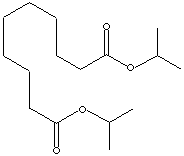PRODUCT IDENTIFICATION

H.S. CODE
CLASSIFICATION
TOXICITY
PHYSICAL AND CHEMICAL PROPERTIES
MELTING POINT
SOLUBILITY IN WATER
REFRACTIVE INDEX
1.4300
NFPA RATINGS
Health: 1, Flammability: 1, Reactivity: 0
AUTOIGNITION
APPLICATIONS
- Plasticizer for polymers
- Biodegradable solvents and lubricants
- Engineering plastics
- Epoxy curing agent
- Adhesive and powder coating
- Corrosion inhibitor
- Perfumery and pharmaceutical
- Electrolyte
There are almost infinite esters obtained from carboxylic acids. Esters are formed by removal of water from an acid and an alcohol. Carboxylic acid esters are used as in a variety of direct and indirect applications. Lower chain esters are used as flavouring base materials, plasticizers, solvent carriers and coupling agents. Higher chain compounds are used as components in metalworking fluids, surfactants, lubricants, detergents, oiling agents, emulsifiers, wetting agents textile treatments and emollients, They are also used as intermediates for the manufacture of a variety of target compounds. The almost infinite esters provide a wide range of viscosity, specific gravity, vapor pressure, boiling point, and other physical and chemical properties for the proper application selections.
|
C length (Straight) |
Product |
CAS # |
Melting Point |
Boiling Point |
|
C 2 |
Oxalic
Acid (Ethanedioic Acid) |
144-62-7 |
189 - 191 C |
Sublimes |
|
C 3 |
Malonic
Acid |
141-82-2 | 131 - 135 C |
Decomposes |
|
C 4 |
Succinic
Acid |
110-15-6 |
185 - 190 C |
235 C |
|
C 5 |
Glutaric
Acid |
110-94-1 |
95 - 99 C |
302 C |
|
C 6 |
Adipic
Acid |
124-04-9 |
151 - 153 C |
265 C at 100 mmHg |
|
C 7 |
Pimelic
Acid |
111-16-0 |
105 - 106 C |
212 C at 10 mmHg |
|
C 8 |
Suberic
Acid |
505-48-6 |
143 - 144 C |
230 C at 15 mmHg |
|
C 9 |
Azelaic
Acid |
123-99-9 |
100 - 103 C |
237 C at 15 mmHg |
|
C 10 |
Sebacic
Acid |
111-20-6 |
131 - 134 C |
294 at 100 mmHg |
|
C 11 |
Undecanedioic acid | 1852-04-6 |
109 - 110 C |
|
|
C 12 |
Dodecanedioic acid | 693-23-2 |
128 - 129 C |
245 C at 10 mmHg |
|
C 13 |
Brassylic acid (Tridecanedioic acid) |
505-52-2 |
112 - 114 C |
|
|
C 14 |
Tetradecanedioic acid | 821-38-5 |
126 - 128 C |
|
|
C 15 |
Pentadecanedioic acid | 1460-18-0 |
|
|
|
C 16 |
Thapsic acid (Hexadecanedioic acid) |
505-54-4 |
124 - 126 C |
|
|
C 18 |
Octadecanedioic acid |
871-70-5 |
|
|
SEBACIC ACID (also called decanedioic acid ) is a white flake or powdered crystal. It is resolved in ethanol, ether and soluble slightly in water. SEBACIC ACID was named from the Latin sebaceus (tallow candle) or sebum (tallow) in reference to its use in the manufacture of candles. SEBACIC ACID and its derivatives, as azelaic acid, have a variety of industrial uses as plasticizers, lubricants, diffusion pump oils, cosmetics, candles, etc. It is also used in the synthesis of polyamide, as nylon, and of alkyd resins. An isomer, isosebacic acid, has several applications in the manufacture of vinyl resin plasticizers, extrusion plastics, adhesives, ester lubricants, polyesters, polyurethane resins and synthetic rubber.
APPEARANCE
25 max
SPECIFIC GRAVITY
0.933 ± 0.001
REFRACTIVE INDEX
1.4300 - 1.4340
ACID VALUE
1.0 max ( mg KOH/g)
380 - 400 (mg KOH/g)